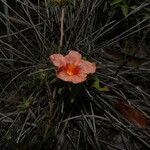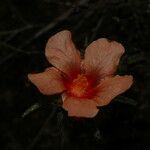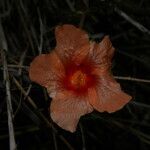Herb, perennial, or suffrutex, up to 45 cm high but usually shorter, the stem prostrate to ascending or erect, diffusely branched from the base, strigose-pubescent, often hirsute to tomentose toward the apex, the hairs mostly stellate or submal-pighiaceous. Leaves with the pedicel geniculate at the apex, 3-9 mm long, hirsute and strigose-pubescent with stellate and submalpighiaceous hairs, the stipules linear to spatulate, acute to acuminate, 6-12 mm long, ciliate; blade small, very variable, mostly linear to narrowly oblong to oblong to ovate, sometimes subcircular, truncate to rounded or narrowly cordate at the base, acute to obtuse at the apex, to 2.5 cm long, the margins variably serrate above the base or only near and at the apex, sometimes merely 3-dentate apically, 3-to 5-palminerved, the upper surface glabrous or with few, appressed, simple or stellate hairs, the lower one more or less densely strigose-pubescent with stellate or submalpighiaceous hairs, and with the main veins prominulous. Flowers in terminal 2-to 8-flowered clus-ters, these subtended by the uppermost leaves and the hirsute-ciliate, stipule-like bracts, rarely axillary and solitary, the pedicel ca 1-2 mm long, adnate to the petiole of the subtending leaf or bract; calyx campanulate, terete, 5-7 mm long, villous with simple or stellate hairs or with both, persistent, the lobes triangular to narrowly ovate, acute, 2-4 mm long; petals obovate-spatulate to broadly rotund-triangular, more or less oblique, obtuse or retuse at the apex, 3-15 mm long and 2-10 mm wide, white, yellow, pink or purple, glabrous or sparsely puberulus at the base; staminal tube 3-5 mm high, glabrous or sparsely puberulus, the filaments 2-3 mm long; styles 4-8 mm long, connate below. Mericarps 5-8, trigonous, muti-cous to shortly 2-aristate apically, 2-3 mm high, chartaceous-coriaceous, the dorsum prominently muricate to rugose, glabrous to densely and minutely stellate-puberulus, the lateral walls rather coarsely reticulate; seeds trigonous-subrotund, ca 1.7 mm long, with scattered minute stellate hairs, these denser near the hilum.
More
Herbs, probably perennial, 0.1–0.3 m. Stems procumbent, branched from base, with appressed, stellate, usually 4-rayed hairs. Leaves usually crowded at stem apex; stipules partially adnate to petiole, 1-veined, linear to oblanceolate, 4–12 mm, usually longer than petiole; petiole 2–10 mm, 1/4–1/2 length of blade, with appressed stellate hairs; blade narrowly elliptic, 1–2 cm, usually 2–3 times longer than wide, base truncate to subcordate, margins dentate apically, entire basally, apex acute or obtuse, surfaces stellate-hairy abaxially, glabrous adaxially. Inflorescences terminal, subsessile, usually 1–10-flowered, flowers crowded at branch apices because of shortening of internodes, obscurely solitary, axillary. Pedicels adnate to petiole of leaflike bract, 0.1–0.4 cm, shorter than calyx. Flowers: calyx obscurely angulate, 4–6 mm, hirsute, lobes ovate; petals usually salmon-pink, red-orange, sometimes yellowish, 5–11 mm; staminal column hairy; style 5–8-branched. Schizocarps conic, 5–6 mm diam., subglabrous; mericarps 5–8, prominently muricate, otherwise glabrous. 2n = 16.



